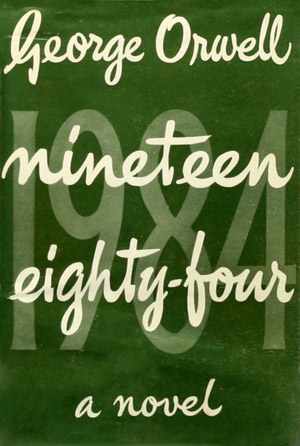
Songs mentioned in the article include some well-known standards and several lyrics which were invented by Huxley and Orwell for the novels. Music settings are by Alex MacDonald, unless otherwise indicated.
Huxley’s attitude to the jazz music of the 1920s was scornful. In an essay written shortly before Brave New World, he singled out “Yes, Sir, That’s My Baby” as a particularly egregious example.
This song and other standards are available on the internet in versions by many different performers, so they are not included here.
The Brave New Worlders are to be happy all the time. The late 1920s produced quite few songs more related to the utopian Cockagne fantasy than to recognizable reality. For example, although Irving Berlin’s “Blue Skies” does give a nod to “blue days,” meaning sad days, its promise of “blue skies from now on” is the dominant note. Other examples of blue skies positive thinking might include “My Blue Heaven” and “On the Sunny Side of the Street.” Huxley’s contribution to the genre is "Bottle of Mine," performed at the Westminster Cabaret by Calvin Stopes and his Sixteen Sexophonists.
The Solidarity Service attended by Bernard Marx is intended to promote unity, although for Bernard the magic does not happen. The music of the service expresses Huxley’s life-long pre-occupation with the dualism of spirit and flesh: "Ford We Are One" and "Orgy Porgy."
The girls of the Brave New World are described as “pneumatic,” with Lenina being a particularly pneumatic example. One obvious source for the term is the automobile, rapidly becoming a social phenomenon as well as a mode of transportation. “If You Knew Suzie” also uses a term from automobiles to describe her: “Holy Moses, what a chassis!” Lenina’s theme song is
"Hug Me Till You Drug Me." It is set here to the tune of "Put Your Arms Around Me, Honey (Von Tilzer/McCree) a 1910 song which was re-recorded in 1931 by a popular London orchestra, as Huxley was writing Brave New World.
A counterpoint to the mindless jazz tunes of the Brave New World is a poem by Helmholtz Watson, his "Rhymes about Being Alone."
The prole woman whose singing is overheard by Winston Smith in Nineteen Eighty-Four is another individual voice in a relentlessly collectivist dystopian state. She sings a song written by the “versificator”: "It Was Only an 'opeless Fancy."Winston calls it terrible rubbish, yet it has a strange attraction for him and is a sign of hopefulness he cannot explain.
 Nineteen Eighty-Four alludes to two songs of the late 1930s which became “huge hits” during World War II, on the radio, in recordings by Vera Lynn and other artists, and in wartime movies. The words “We’ll Meet Again” appear three separate times in the novel but, in contrast to the song, they have a much darker and ironic meaning when they are spoken by the torturer O’Brien. The lyrics of “I’ll Be Seeing You,” share a number of important details with the ending of the novel. The effect is also ironic, as Winston and Julia at the end have no desire to see each other again, all of their emotional selves now re-directed to Big Brother. The article suggests that despite the irony, allusions to such popular pieces about the re-union of lovers would carry a positive and hopeful valence, to support the notion that there is a sub-text of hope in the novel which extends beyond the Newspeak Appendix.
Nineteen Eighty-Four alludes to two songs of the late 1930s which became “huge hits” during World War II, on the radio, in recordings by Vera Lynn and other artists, and in wartime movies. The words “We’ll Meet Again” appear three separate times in the novel but, in contrast to the song, they have a much darker and ironic meaning when they are spoken by the torturer O’Brien. The lyrics of “I’ll Be Seeing You,” share a number of important details with the ending of the novel. The effect is also ironic, as Winston and Julia at the end have no desire to see each other again, all of their emotional selves now re-directed to Big Brother. The article suggests that despite the irony, allusions to such popular pieces about the re-union of lovers would carry a positive and hopeful valence, to support the notion that there is a sub-text of hope in the novel which extends beyond the Newspeak Appendix.
The Chestnut Tree Café is the site of Winston and Julia’s final conversation. The telescreen is constantly reporting false news about the endless war with alternating enemies and playing music which is tinny, cracked and braying. "The Chestnut Tree" (Kennedy/Connor/Kennedy) was a popular song and dance “sensation” of the time. The demonstration here includes a relatively normal rendition followed by a rendition to simulate the unpleasant music from the telescreen.
Thanks to the following, who have helped with this audio appendix: Catherine Arthur-MacDonald, Colin MacDonald, Grant Hall of Touchwood Studios, Carl Shields, Iain MacDonald of Avonlea Communications.
Brave New World cover image: By Source, Fair use, Link
Nineteen Eighty-four cover image: public domain